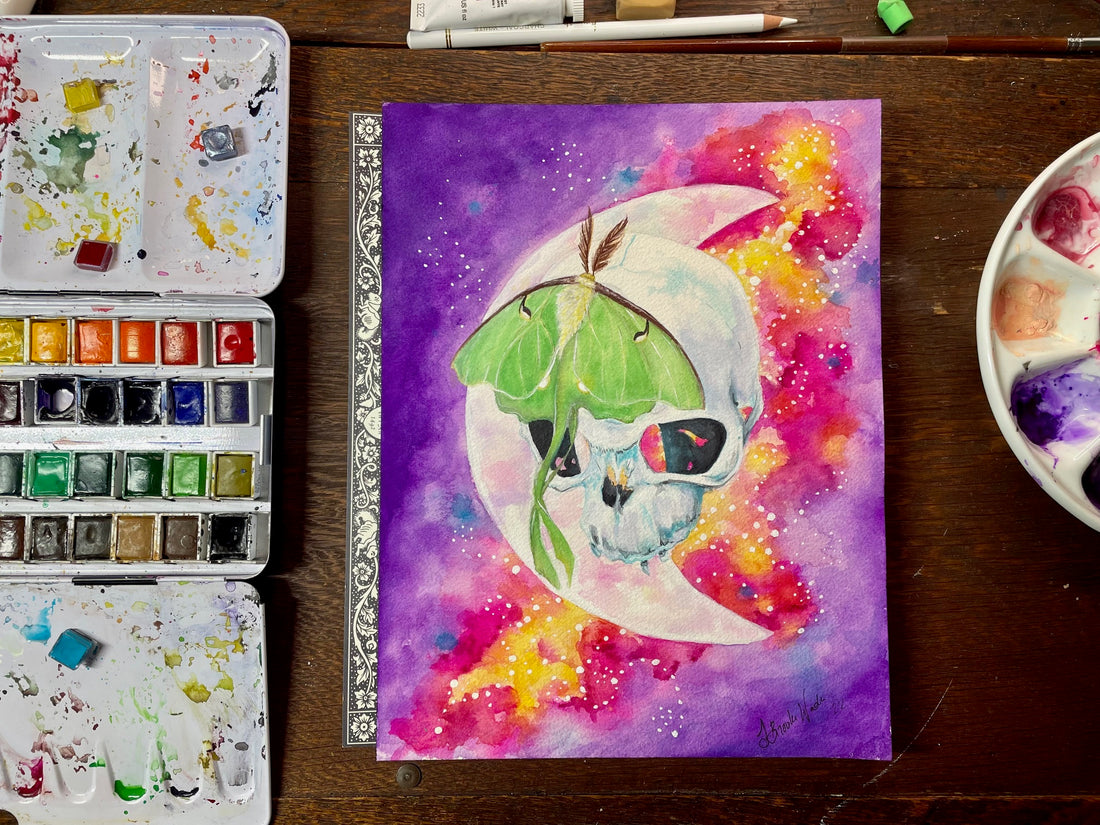
The Magic Behind the Brush: The Ingredients of Watercolor Paint
Share
Unpacking the Palette: The Ingredients of Watercolor Paint
As a dedicated watercolor artist, there's a special kind of joy in knowing precisely what goes into my palette. For enthusiasts and aspiring painters keen to understand this medium, let’s explore what watercolor paint is made of. The blend of simple yet impactful components that compose watercolor paints not only deepens our connection with each stroke but also elevates the art we create.
The Fundamental Elements of Watercolor Paint
Pigment: The Essence of Color
At the heart of every watercolor paint lies the pigment. These are the finely ground particles responsible for imparting color. Sourced from various origins like minerals, plants, and synthetic materials, pigments define more than just the shade—they influence the paint’s transparency, staining quality, and resistance to light fading, known as lightfastness. Natural pigments, such as those derived from earth minerals, offer a rich, earthy palette, while synthetic pigments can produce more vibrant and varied hues. The quality and type of pigment used directly affect the paint's performance, dictating how it interacts with water and paper.
Binder: The Cohesive Force
To bind the pigment particles and ensure they adhere to the paper, watercolor paints contain a binder. Gum arabic, derived from the sap of acacia trees, is the most prevalent binder. This natural gum is clear and dissolves well in water, enhancing the paint’s luminous transparency and facilitating smooth applications. The binder’s role is crucial because it determines the paint's texture and how well it sticks to the surface once applied. Without a proper binder, pigments would simply fall off the paper or canvas, rendering the paint useless.
Additives: Tailoring Paint Performance
To further refine the paint’s behavior, various additives are included. These additives adjust the paint’s viscosity, spreadability, and drying time, allowing artists to achieve specific effects.
Glycerin or Honey: Moisture Retainers
Glycerin and honey are humectants that help maintain the paint's moisture and improve its flow. They keep the paint from drying out too quickly on the palette, making it easier to work with for extended periods. These additives also contribute to the paint’s re-wettability, which is particularly useful for artists who prefer to revisit and adjust their work.
Ox Gall or Humane Alternatives: Wetting Agents
Ox gall, traditionally used as a wetting agent, allows the paint to spread more uniformly, minimizing streaks and aiding in creating smooth washes. However, due to ethical considerations, many modern watercolor paints now use synthetic or plant-based wetting agents that perform the same function without animal-derived ingredients.
Preservatives: Mold Combatants
Watercolor paints are susceptible to mold growth in damp conditions. To combat this, preservatives are added to ensure the longevity of the paint. These preservatives help maintain the integrity of the paint over time, especially in more humid environments where mold and mildew can be a concern.
Water: The Element of Transformation
Water is the transformative agent in what watercolor paint is made of. It activates the dry paint, allowing the pigments to flow freely with the water, producing everything from vibrant strokes to delicate washes. The amount of water used can dramatically alter the appearance of the final piece, from bold, opaque lines to gentle, see-through layers. Water not only dilutes the paint but also affects the granulation and texture of the application. Artists can experiment with different water-to-paint ratios to discover a wide range of effects and techniques.
Artistic Implications of Watercolor Composition
Understanding the components of watercolor paints equips artists like myself to better manipulate the medium for desired outcomes. Recognizing whether pigments are granulating (settling into the paper's texture for a grainy finish) or non-staining (easily lifted off the paper) guides my technique, especially in color layering. Granulating pigments add texture and depth to a painting, while non-staining pigments are ideal for creating clean, layered washes.
This knowledge also empowers artists to select materials that align with their artistic vision and requirements. Some may prefer organic pigments for their natural hues and environmental benefits, while others might choose synthetic pigments for brighter and more striking colors. Knowing the properties of each pigment helps in predicting how they will behave on paper, thus allowing for more controlled and deliberate artistic expressions.
Exploring the Science Behind the Art
The composition of watercolor paints is a fascinating intersection of art and science. Each component—pigment, binder, additive, and water—plays a pivotal role in defining the paint’s characteristics. This interplay between materials and their properties opens up a world of creative possibilities. For instance, understanding the role of the binder can help artists achieve the perfect balance between transparency and vibrancy in their work. Similarly, knowing how different additives influence the paint’s behavior can lead to more refined and controlled techniques.
Practical Tips for Artists
For artists looking to experiment with their watercolor paints, here are a few practical tips:
-
Experiment with Pigments: Try using different pigments to see how they interact with each other. Notice which pigments granulate and which ones create smooth, even washes.
-
Adjust Water Ratios: Play with the amount of water you mix with your paint. Observe how varying the water-to-paint ratio affects the intensity and transparency of your colors.
-
Explore Additives: If you make your own paints or buy raw materials, experiment with adding glycerin or honey to see how it changes the paint’s texture and flow.
-
Test on Different Papers: Different watercolor papers can dramatically affect the outcome of your painting. Test your paints on various types of paper to find the one that best suits your style.
-
Understand Lightfastness: Choose pigments with high lightfastness ratings for works that will be displayed in well-lit areas to ensure your artwork retains its vibrancy over time.
Bringing it All Together: The Art and Science of Watercolor Paints
Watercolor paints, with their rich composition of pigments, binders, and additives, illustrate the beautiful synergy between art and science. Each ingredient plays a pivotal role in defining the paint’s characteristics, thereby influencing the artistic possibilities of this medium. Whether you're just starting out or simply curious about the craft, understanding what watercolor paint is made of enriches your appreciation for this exquisite art form and the stunning artworks it produces.
By delving into the materials used in watercolor painting, I aim to inspire both present and future generations of artists to embrace and perpetuate the tradition of watercolor painting, crafting pieces that reflect the beauty and intricacy of our world. The more we understand the components and their interactions, the more we can push the boundaries of what we create, bringing to life the magic behind the brush.
In conclusion, watercolor painting is not just about the visual outcome but also about the intricate process and the materials that make it possible. Every stroke, every blend, and every wash carries with it the essence of centuries-old practices combined with modern innovations. By appreciating and understanding the ingredients that make up our watercolor paints, we not only enhance our technical skills but also deepen our connection to this timeless art form. So, let’s continue to explore, experiment, and create, always mindful of the beautiful science that makes our art possible.
